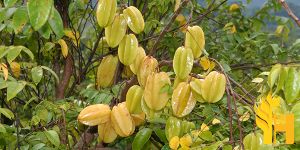Carambola price

Where to buy and sell Carambola, lowest (cheapest) and highest price.
check offers buy sell CarambolaToday price for CarambolaCarambola wholesale prices 2022
The Current commodity price of Carambola per kg, pound in the world in the global markets
carambola kg
Price range: 4.25 - 12 EUR / 1 kg | Market: Supply Central Markets Sevilla | Date: 2025-11-24
carambola kg
Price range: 4.25 - 11.93 EUR / 1 kg | Market: Supply Central Markets Sevilla | Date: 2025-11-17
carambola kg
Price range: 4.25 - 11.65 EUR / 1 kg | Market: Supply Central Markets Sevilla | Date: 2025-11-10
carambola kg
Price range: 4.25 - 11.65 EUR / 1 kg | Market: Supply Central Markets Sevilla | Date: 2025-11-03
carambola kg
Price range: 4.25 - 11.65 EUR / 1 kg | Market: Supply Central Markets Sevilla | Date: 2025-10-27
carambola kg
Price range: 4.25 - 11.65 EUR / 1 kg | Market: Supply Central Markets Sevilla | Date: 2025-10-20
carambola kg
Price range: 4.25 - 11.65 EUR / 1 kg | Market: Supply Central Markets Sevilla | Date: 2025-10-13
carambola kg
Price range: 4.25 - 10.39 EUR / 1 kg | Market: Supply Central Markets Sevilla | Date: 2025-10-06
carambola kg
Price range: 4.25 - 8.5 EUR / 1 kg | Market: Supply Central Markets Sevilla | Date: 2025-09-29
carambola kg
Price range: 4.25 - 8.5 EUR / 1 kg | Market: Supply Central Markets Sevilla | Date: 2025-09-22
Carambola
The carambola is a small tree. 5 to 12 m high, with a short trunk. It is quite attractive and ornamental, with pale green leaves. The flowers are gathered in clusters. This tree needs a tropical or subtropical climate, with quite humid weather.The carambola is a tropical fruit that has recently started its trade in Europe. It is also called the star fruit because it is star-shaped when cut on a cross-section. It has a thin edible skin, of pale yellow color that turns into golden yellow when the fruit is ripe. It has a translucent, crispy, and acid pulp.
Fresh it is used to be eaten as such, or in salads, fruit salads, and juices. But nowadays is used mainly for processing, since its chemical composition makes it a good vitamin C concentrate if boiled with sugar, and it is an excellent source of pectin when boiled with water.
The fruit is ready to be eaten once it becomes golden yellow and the seeds are dark brown. The pulp should also be translucent and crispy, not mealy or mushy. Seeds: There are not many seeds in a fruit, but since they are large and flat, the presence of even one or two is noticeable. They should be dark brown and not injured.
The carambola is a fruit that is grown for its taste and smell as much as for its appearance, which makes it very appreciated by those who eat it. The smell of the ripe fruit is intense and pleasant, but fresh carambolas do have not much smell at all.
Its flesh is soft and crispy, translucent and acid. It is usually eaten as such, but the pulp is now used mainly for processing, as it has great vitamin C concentrate potential as well as pectin if boiled with sugar.
Carambola production is a major global industry. Top producers of carambola in the world market include Australia, Guyana, India, Israel, Malaysia, the Philippines, Taiwan, and the United States. In the United States, Carambola plants are grown in tropical and semitropical areas, including parts of Florida and Hawaii. Carambola trees in the United States are a popular landscape tree for home gardens and parks.
Global carambola production
Carambola, also known as starfruit, is a tropical fruit that grows on trees in warm climates. The fruit is yellow or green when ripe and has five pointed lobes. Carambola is native to Southeast Asia but is now grown in many tropical countries around the world. The largest producers of carambola are Indonesia, India, the Philippines, Thailand, and Vietnam. Carambola is a relatively new fruit crop in many of these countries and production levels are still low. However, demand for fruit is growing rapidly, especially in developed countries such as the United States, where carambola is becoming increasingly popular as a healthy, exotic fruit option. In 2010, global production of carambola was estimated at around 80,000 metric tons. Indonesia is the largest producer of carambola, with an estimated production of 40,000 metric tons in 2010. India is the second largest producer of carambola, with an estimated production of 15,000 metric tons in 2010. Other significant producers include the Philippines, Thailand, and Vietnam. The vast majority of carambola produced in the world is consumed locally within the country of origin. However, a small but growing amount of fruit is being exported to developed countries such as the United States, where demand for exotic fruits is increasing. Carambola exports from Indonesia to the United States have been growing rapidly in recent years, reaching an estimated value of $5 million in 2010.Download our new
Husfarm App
Stay up to date with the current prieces of agricultural products all over the world.
Do you want to sell agricultural products?
Are you an Agricultural processor looking for high-quality products to buy?
Post an ad for FREE!
